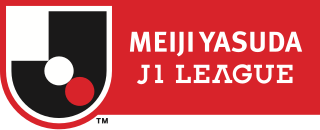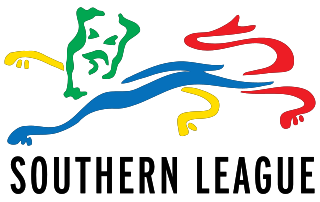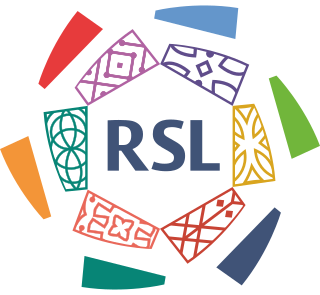Related Research Articles

The EFL Cup, currently known as the Carabao Cup for sponsorship reasons, is an annual knockout competition in men's domestic football in England. Organised by the English Football League (EFL), it is open to any club within the top four levels of the English football league system—92 clubs in total—comprising the top-level Premier League, and the three divisions of the English Football League's own league competition.

The Isthmian League is a regional football league covering Greater London, East and South East England, featuring mostly semi-professional clubs.
The Northern Premier League is an English football league that was founded in 1968. Together with the Isthmian League and the Southern League it forms levels seven and eight of the English football league system.

The J1 League, a.k.a the J.League or the Meiji Yasuda J1 League for sponsorship reasons, is the top level of the Japan Professional Football League system. Founded in 1992, it is one of the most successful leagues in Asian professional club football history. Contested by 20 clubs, it operates on a system of promotion and relegation with the J2 League. It was known as the J.League from 1993 to 1998 before becoming a two-division league, and as J.League Division 1 from 1999 to 2014.
The Scottish football league system is a series of generally connected leagues for Scottish football clubs.

The Southern League is a football competition featuring semi-professional clubs from East Anglia, the South and Midlands of England, and South Wales. Together with the Isthmian League and the Northern Premier League it forms levels seven and eight of the English football league system.
The English football league system, also known as the football pyramid, is a series of interconnected leagues for men's association football clubs in England, with five teams from Wales, one from Guernsey, one from Jersey and one from the Isle of Man also competing. The system has a hierarchical format with promotion and relegation between leagues at different levels, allowing even the smallest club the theoretical possibility of ultimately rising to the very top of the system, the Premier League. Below that are levels 2–4 organised by the English Football League, then the National League System from levels 5–10 administered by the FA, and thereafter Regional feeder leagues run by relevant county FAs on an ad hoc basis. It also often happens that the Premier Division of a Regional Feeder League has its constitution given to it by the FA. They have to accept it or appeal but cannot reject it at an annual general meeting.

In sports leagues, promotion and relegation is a process where teams can move up and down between multiple divisions arranged in a hierarchical structure, based on their performance over a season. Leagues that use promotion and relegation systems are often called open leagues. In a system of promotion and relegation, the best-ranked team(s) in a lower division are promoted to a higher division for the next season, and the worst-ranked team(s) in the higher division are relegated to the lower division for the next season. During the season, teams that are high enough in the league table that they would qualify for promotion are sometimes said to be in the promotion zone, and those at the bottom are in the relegation zone.
Non-League football describes football leagues played outside the top leagues of a country. Usually, it describes leagues which are not fully professional. The term is primarily used for football in England, where it is specifically used to describe all football played at levels below those of the Premier League and the three divisions of the English Football League. Currently, a non-League team would be any club playing in the National League or below that level. Typically, non-League clubs are either semi-professional or amateur in status, although the majority of clubs in the National League division are fully professional, some of which are former EFL clubs who have suffered relegation.

The Bundesliga, sometimes referred to as the Fußball-Bundesliga or 1. Bundesliga, is a professional association football league in Germany. At the top of the German football league system, the Bundesliga is Germany's primary football competition. The Bundesliga comprises 18 teams and operates on a system of promotion and relegation with the 2. Bundesliga. Seasons run from August to May. Games are played on Fridays, Saturdays and Sundays. All of the Bundesliga clubs take part in the DFB-Pokal cup competition. The winner of the Bundesliga qualifies for the DFL-Supercup.
The National League, known as the Vanarama National League for sponsorship reasons, is the highest level of the National League System and fifth-highest of the overall English football league system. It is the highest league that semi-professional teams in the English football league system play. Notable former English Football League clubs that compete in the National League include: Chesterfield, Oldham Athletic, Rochdale, York City, Hartlepool United and Southend United. The National League is the lowest division in the English football pyramid organised on a nationwide basis. Formerly the Conference National, the league was renamed the National League from the 2015–16 season.

In sports, a farm team, farm system, feeder team, feeder club, or nursery club is generally a team or club whose role is to provide experience and training for young players, with an agreement that any successful players can move on to a higher level at a given point, usually in an association with a major-level parent team. This system can be implemented in many ways, both formally and informally. It is not to be confused with a practice squad, which fulfills a similar developmental purpose but the players on the practice squad are members of the parent team.
In European football, the UEFA coefficients are statistics based in weighted arithmetic means used for ranking and seeding teams in club and international competitions. Introduced in 1979 for men's football tournaments, and after applied in women's football and futsal, the coefficients are calculated by UEFA, who administer football within Europe, as well as Armenia, Cyprus, Israel and the Asian parts of some transcontinental countries.
In sporting terminology, a youth system is a youth investment program within a particular team or league, which develops and nurtures young talent in farm teams, with the vision of using them in the first team in the future if they show enough promise and potential, and to fill up squad numbers in some teams with small budgets. In contrast to most professional sports in the United States where the high school and collegiate system is responsible for developing young sports people, most football and basketball clubs, especially in Europe and Latin America, take responsibility for developing their own players of the future.
The German football league system, or league pyramid, refers to the hierarchically interconnected league system for association football in Germany that in the 2016–17 season consisted of 2,235 leagues in up to 13 levels having 31,645 teams, in which all divisions are bound together by the principle of promotion and relegation. The top three professional levels contain one division each. Below this, the semi-professional and amateur levels have progressively more parallel divisions, which each cover progressively smaller geographic areas. Teams that finish at the top of their division at the end of each season can rise higher in the pyramid, while those that finish at the bottom find themselves sinking further down. Therefore, in theory, it is possible for even the lowest local amateur club to rise to the top of the system and become German football champions one day. The number of teams promoted and relegated between the divisions varies, and promotion to the upper levels of the pyramid is usually contingent on meeting additional criteria, especially concerning appropriate facilities and finances.
Professional sports leagues are organized in numerous ways. The two most significant types are one that developed in Europe, characterized by a tiered structure using promotion and relegation in order to determine participation in a hierarchy of leagues or divisions, and a North American originated model characterized by its use of franchises, closed memberships, and minor leagues. Both these systems remain most common in their area of origin, although both systems are used worldwide.

The Saudi Pro League (SPL), known as the Roshn Saudi League (RSL) for sponsorship reasons, is the highest division of association football in the Saudi league system.

The Australian soccer league system is the league structure for soccer clubs in Australia. The league system in Australia since 1977 has involved one top divisional league controlled by Football Australia and many leagues run within each state below. The National Soccer League stood from 1977 to 2004 as the top nationwide tier above the current state-based league systems, in 2005, the A-League was established as its successor. The introduction of the National Premier Leagues in 2013 introduced a direct second tier of soccer in Australia, underpinning the A-League. The National Premier Leagues incorporated the existing state leagues as divisions with a nationwide end of season finals series. In 2013, the National Premier Leagues rebranded 5 of the 9 top state leagues, and the remainder – with the exception of the Northern Territory – joined in 2014. There is no promotion and relegation to and from the top-tier A-League, and promotion and relegation at other levels varies between different state systems.
The Football League First Division was a division of the Football League in England from 1888 until 2004. It was the top division in the English football league system from the season 1888–89 until 1991–92, a century in which the First Division's winning club became English football champions.